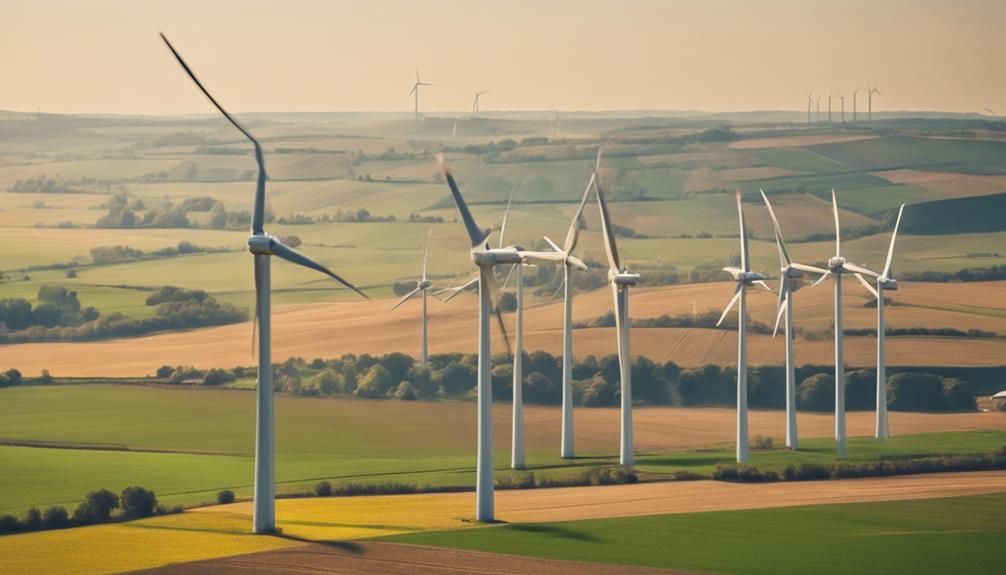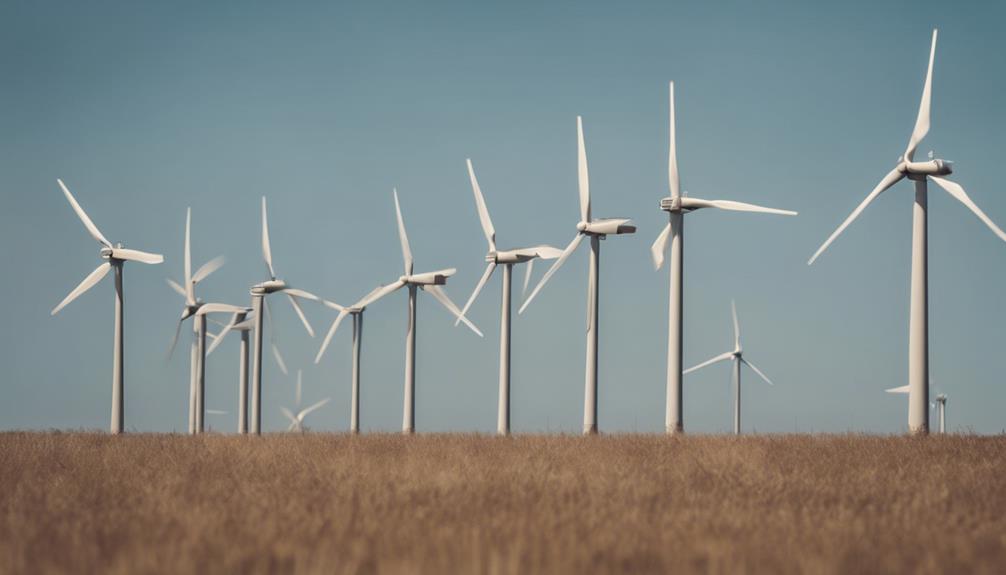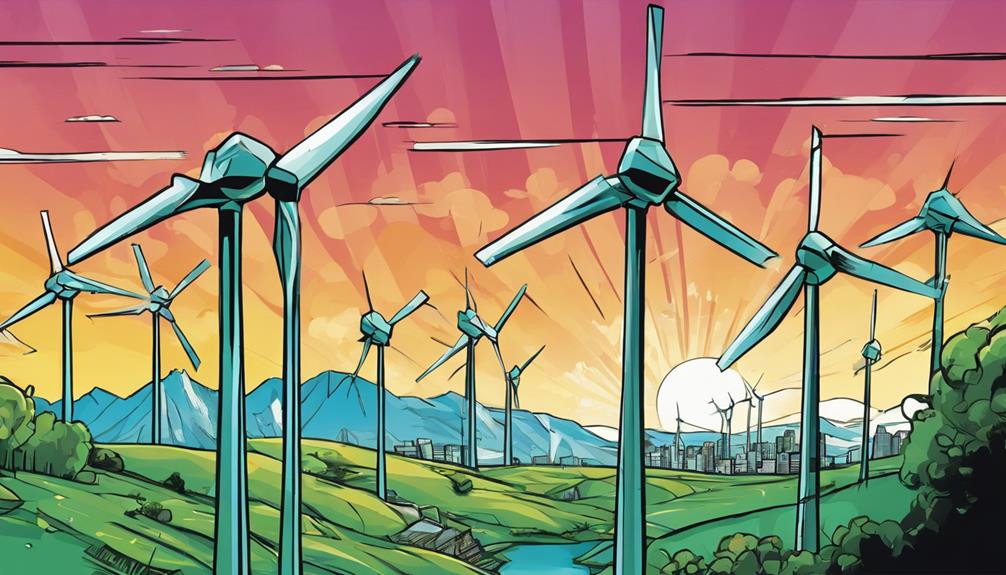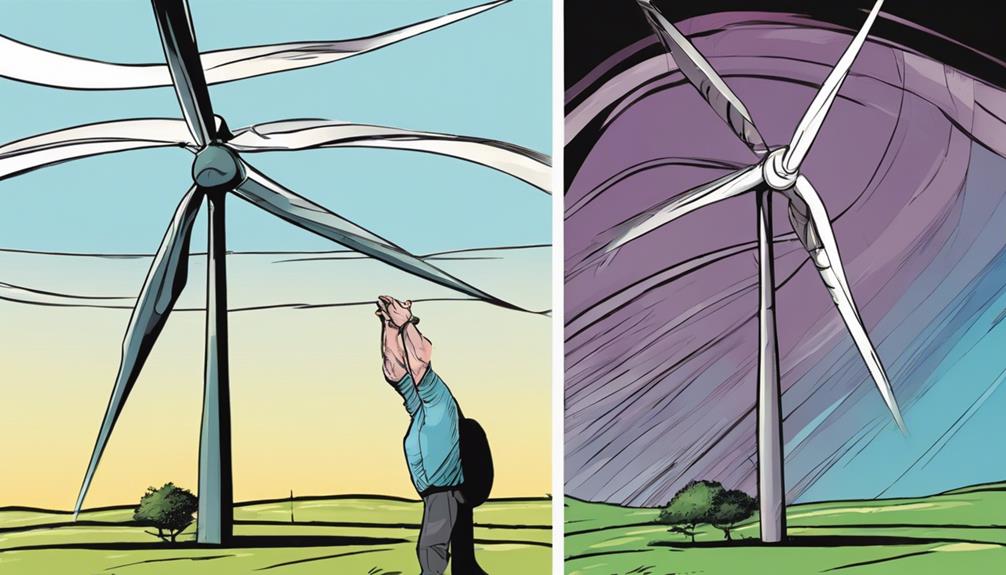If you're wondering, a wind turbine can bring in $3,000 to over $10,000 yearly for smaller setups. The bigger turbines could even fetch $80,000 a year. This shows promising earning potential in the renewable energy field. Evolving further into the topic can offer deeper insights into the various factors influencing wind turbine profitability and revenue generation.
Key Takeaways
- Wind turbine revenue varies based on capacity and efficiency.
- Larger turbines can earn $50,000 to $80,000 annually.
- Multiple turbines lead to substantial income for owners.
- Initial investment costs can be recouped within 5-15 years.
- Annual earnings are influenced by electricity production and turbine size.
Wind Turbine Revenue Generation
When considering wind turbine revenue generation, understanding the potential income range per turbine and how it can vary based on factors like capacity and operational efficiency is essential.
Wind turbine revenue stems from the annual income generated through electricity production. Turbines with higher capacities have the potential to earn more annually, ranging from $3,000 to over $10,000 per turbine.
The electricity production of these turbines plays a significant role in determining the revenue they generate. Typically operating at 35-65% capacity, the efficiency of the turbine directly impacts the total revenue.
Farmers hosting wind turbines can benefit from this steady income stream, especially if they've multiple turbines, as it can lead to substantial annual income from wind energy production.
Essentially, the revenue potential of wind turbines is closely tied to their capacity and operational efficiency, making them vital factors in determining annual earnings.
Wind Turbine Leasing Income

Wind turbine leasing agreements offer landowners the chance to earn income by renting out their land for the installation and operation of wind turbines. Typically, wind turbine leases provide yearly payments per turbine set up on the land. These payments can vary from $2 to $10 per acre annually for a duration of 3 to 5 years.
Once the wind turbines become operational, landowners may shift to receiving payments based on the electricity production generated by the turbines. The amount of payment a landowner receives through wind turbine leasing can vary significantly by location. For example, in North Dakota, wind turbine leases can yield between $4,000 to $6,000 per megawatt.
Some leasing contracts also include royalties based on electricity sales, further enhancing the overall income from leasing land for wind turbines. It's vital for landowners to negotiate long-term contracts, usually spanning 20 to 25 years, with provisions for annual rate increases to safeguard their interests against inflation.
Wind Turbine Land Requirements

To effectively utilize land for wind turbine installations, it is essential to understand the specific requirements involved in accommodating these structures. Wind turbines typically require 1-2 acres of land per turbine for installation and operation. Additionally, extra land is necessary for access roads, maintenance, and safety zones around the turbines. The amount of land needed can vary depending on the turbine capacity and the spacing between turbines.
When it comes to land lease agreements for wind turbines, they often span 20-25 years, offering landowners a consistent income stream. These contracts may also include provisions for adjusting land lease payments over time to consider factors like inflation. Properly managing land requirements and lease agreements is crucial for maximizing the benefits of wind turbine installations for both the landowners and the operators.
| Aspect | Details |
|---|---|
| Land Requirements | 1-2 acres per turbine |
| Additional Land | Needed for access roads, maintenance, safety |
| Turbine Capacity | Impacts the size of land required |
| Lease Agreement Length | Typically 20-25 years |
| Payment Adjustments | May consider inflation over time |
Wind Turbine Longevity

Discovering the lifespan of wind turbines and the factors influencing their longevity is essential.
Proper maintenance practices and environmental conditions play a significant role in determining how long a wind turbine can generate energy efficiently.
Lifespan of Turbines
Over time, the lifespan of wind turbines plays a pivotal role in determining their overall profitability. Well-installed turbines have a lifespan ranging from 20 to 30 years, impacted by maintenance and environmental conditions.
For wind turbines to remain profitable, proper maintenance is essential. Ensuring that turbines are well-maintained allows them to continue generating electricity efficiently throughout their operational life.
The profitability of wind turbines is directly linked to their longevity, making it imperative for landowners and developers to focus on extending their lifespan. Regular maintenance and monitoring are key strategies to prolong the operational lifespan of wind turbines, ultimately influencing the return on investment for those involved in wind energy projects.
Turbine Longevity Factors
Factors influencing the longevity of wind turbines include proper upkeep practices and the impact of environmental conditions on their operational lifespan. When it comes to ensuring the durability of wind turbines, here are three critical points to keep in mind:
- Wind Turbine Maintenance:
Regular upkeep, including inspections and timely repairs, is crucial for maximizing the lifespan of wind turbines. Neglecting maintenance can lead to premature wear and tear, reducing the overall endurance of the turbine.
- Environmental Factors:
Environmental conditions such as wind intensity, temperature fluctuations, and exposure to harsh weather can notably affect the durability of wind turbines. Proper siting of the turbine and selecting suitable materials can help mitigate these environmental factors and prolong the turbine's operational life.
- Proper Upkeep Practices:
Following manufacturer guidelines, investing in quality components, and implementing a proactive maintenance plan are essential for ensuring the longevity of wind turbines. By adhering to best practices, you can extend the lifespan of your turbines beyond the typical 20 to 30 years.
Wind Turbine Installation Costs

The installation expenses of wind turbines can fluctuate greatly depending on factors like size, location, and contract terms. For instance, home or farm-scale wind turbines generally range from $3,000 to $8,000 per kilowatt for installation, with a 10-kilowatt turbine installation costing between $50,000 to $80,000.
On a larger scale, commercial wind turbines such as a 2-megawatt turbine may require $2.6 to $4 million for installation. It's worth mentioning that the cost per kilowatt rises with the turbine's size and can be impacted by variables like the required number of turbines and the specific location.
Additionally, the timing of agreements and contract terms can also have a notable effect on the overall installation expenses of wind turbines. Thus, when contemplating the installation of a wind turbine, it's crucial to carefully assess these factors to ascertain the most cost-effective solution for your requirements.
Wind Turbine Maintenance Expenses

Let's break down the maintenance costs of wind turbines, including a closer look at annual expenses.
These costs are important to take into account as they directly impact the overall profitability of wind energy projects.
Understanding the breakdown of maintenance expenses can help you make informed decisions to maximize earnings from your wind turbines.
Maintenance Cost Breakdown
Breaking down wind turbine maintenance expenses involves analyzing the various costs incurred to maintain the smooth operation and longevity of the turbines. Here is a breakdown to help you understand the financial implications of keeping wind turbines in best condition:
- Maintenance Costs: Wind turbine maintenance typically costs between 1-2 cents per kilowatt-hour produced, making it vital to budget for ongoing upkeep.
- Annual Maintenance Expenses: The yearly maintenance expenses for wind turbines can range from $42,000 to $48,000, highlighting the significant financial commitment required for proper upkeep.
- Importance of Lightning Protection: Lightning protection is essential for wind farms to prevent damage and ensure safety. Solutions like StrikeTape offer durable lightning diverters that can safeguard the turbines from potential strikes, emphasizing the need for proactive protective measures.
Understanding these cost breakdowns can help you plan and budget effectively for the maintenance of wind turbines, optimizing their efficiency and longevity.
Annual Maintenance Expenses
Understanding the yearly maintenance expenses for wind turbines is important for effective budgeting and ensuring best performance. Annual maintenance costs for wind turbines typically range from $42,000 to $48,000. These expenses are critical for the ongoing maintenance required to keep wind turbines operating efficiently.
Maintenance costs usually amount to 1-2 cents per kilowatt-hour produced, encompassing various aspects such as insurance, repairs, administrative tasks, and power-related expenses. It's crucial to note that as wind turbines age, the costs of maintenance increase due to the heightened need for upkeep.
Ensuring the proper allocation of funds towards wind turbine maintenance is essential to guarantee the longevity and productivity of these renewable energy sources. By staying proactive in managing annual maintenance expenses, you can optimize the performance of wind turbines and maximize their energy production potential.
Wind Turbine Electricity Production

Wind turbine electricity production showcases the efficiency and sustainability of utilizing wind power to generate energy. Here are some key points to bear in mind:
- Wind turbines are designed to start generating electricity at wind speeds as low as 7 mph, ensuring a consistent flow of renewable energy even during light breezes.
- Turbine owners have the opportunity to sell any excess power back to Utility Companies, not only offsetting their electricity consumption but also potentially earning revenue from their turbines.
- By investing in a wind turbine, owners can expect to recoup their initial investment within a few years through electricity sales, leading to long-term financial benefits while contributing to a cleaner environment.
Utilizing wind power for electricity production not only offers financial advantages but also contributes to a greener and more sustainable future by reducing reliance on traditional fossil fuels.
Wind Turbine Owner Earnings

You can explore the earning potential of wind turbine owners, understanding the financial benefits and income generation analysis.
Learn about how wind turbines can provide substantial yearly income, ranging from $3,000 to over $10,000 per turbine.
Discover the timeline it takes to recoup the initial investment and the environmentally friendly income source they offer.
Earnings Potential Overview
With the potential to earn between $3,000 to $10,000 or more annually per turbine, wind turbine owners can secure a steady stream of income through electricity sales.
- Lucrative Income: Wind turbines, operating at 35-65% capacity, can generate substantial revenue through electricity sales, potentially ranging from $3,000 to over $10,000 per turbine annually.
- Varied Earnings: Larger wind turbines have the potential to earn significantly more, with some generating between $50,000 to $80,000 in a year. On the other hand, smaller turbines may yield around $8,000 annually.
- Scale Impact: Owners with multiple turbines or wind farms can see their earnings multiply, creating a substantial source of income.
The steady revenue streams from these turbines can lead to recouping the initial investment costs within 5-15 years of operation.
Financial Benefits Breakdown
Analyzing the financial benefits of owning wind turbines reveals a breakdown of earnings potential for turbine owners. Wind turbine owners can earn between $3,000 to $8,000 per turbine annually from electricity sales. Larger turbines have the capacity to generate over $10,000 in revenue per year for their owners.
When multiple turbines are installed on a wind farm, the combined revenue can provide substantial annual income for owners. Despite the initial investment, turbine costs are typically recouped within the first 5 to 15 years of operation.
It's remarkable that wind turbines not only contribute to clean energy production but also offer significant financial benefits to their owners through consistent revenue streams. This dual advantage of environmental impact and financial gain makes wind turbine ownership an appealing investment for those looking to diversify their portfolio and support sustainable energy practices.
Income Generation Analysis
Wind turbine owners can realize substantial income through electricity sales, with potential earnings ranging from $3,000 to over $10,000 per turbine annually.
Here's how wind turbines can help you generate income:
- Steady Revenue Streams: Wind turbines offer a reliable source of income through electricity sales, providing owners with a consistent stream of revenue year after year.
- Scalable Earnings: Owners with multiple turbines can greatly boost their annual income, as each additional turbine contributes to the overall revenue generation.
- Investment Recovery: While the initial costs of installing a wind turbine can be substantial, owners can typically recoup their investment within the first 5 to 15 years of operation, leading to long-term financial benefits from renewable energy production.
Wind Turbine Profitability Analysis

To assess the financial viability of wind turbines, it's important to evaluate factors like location-specific wind speeds and project costs. Wind turbine profitability hinges on various elements, including high capacity factors to maximize electricity sales and revenue generation.
These turbines typically pay for themselves through electricity sales over time, with the initial investment costs being offset by long-term earnings. Stakeholders in wind projects focus on optimizing financial returns by ensuring efficient operations.
The profitability of wind energy projects isn't static; it's impacted by advancements in technology, maintenance costs, and the prevailing electricity sale prices in the market. Hence, the financial analysis of wind turbines involves a thorough assessment of these factors to determine the overall profitability and sustainability of the project.
Wind Turbine Performance Evaluation

Understanding how wind speed and direction impact wind turbine performance is vital for evaluating their efficiency. The capacity factor plays an important role in determining the actual electricity production of wind turbines over time.
Here are three key points to keep in mind when assessing wind turbine performance:
- Capacity Factor: Onshore turbines typically operate at 30-40% capacity, while offshore turbines can achieve up to 65% capacity. Higher capacity factors indicate more effective electricity production.
- Wind Variability: Turbines produce electricity at full capacity during peak wind speeds. Variability in wind patterns must be taken into account to evaluate the overall performance of a wind turbine.
- Profitability: Maximizing the capacity factor is crucial for increasing electricity generation and profitability. Turbines aim to operate at higher capacity factors to enhance financial returns over the long term.
Understanding wind variability is essential for optimizing performance and ensuring profitability in the wind energy sector.
Frequently Asked Questions
How Long Does It Take a Wind Turbine to Pay for Itself?
You'll find that a wind turbine typically pays for itself within 5-15 years due to annual payments from utility companies. Factors like location, turbine capacity, and electricity production impact the payback period. Multiple turbines can speed up the return on investment.
How Much Money Does a Land Owner Get From a Wind Turbine?
As a landowner with wind turbines, you can receive $50 to $200 per acre annually through leases. Smaller turbines earn around $8,000 yearly, while larger ones bring in $50,000 to $80,000. Factors affect payments.
What Is the Average Revenue of a Wind Turbine?
On average, a wind turbine can generate annual revenue ranging from $3,000 to over $10,000 per turbine, depending on size and capacity. Owners of multiple turbines on a wind farm can see substantial yearly income.
How Much Do Wind Turbines Earn?
You can earn between $3,000 and $8,000 yearly from a wind turbine. Larger turbines have the potential for over $10,000 annually. Having multiple turbines can bring substantial income. Costs can be recouped within 5 to 15 years.
Does the Amount of Oil Used to Lubricate a Wind Turbine Affect Its Overall Profitability?
When it comes to the profitability of a wind turbine, the amount of oil used for lubrication is a crucial factor. Proper oil lubrication for wind turbines can help minimize maintenance costs and extend the lifespan of the equipment, ultimately boosting its overall profitability.
Conclusion
To sum up, owning a wind turbine can be a lucrative investment, with potential earnings varying based on factors like location and maintenance costs.
The steady stream of income from leasing land for turbine installation can provide a solid foundation for financial growth.
Just like the wind that powers them, these turbines have the potential to keep your pockets filled with green for years to come.









